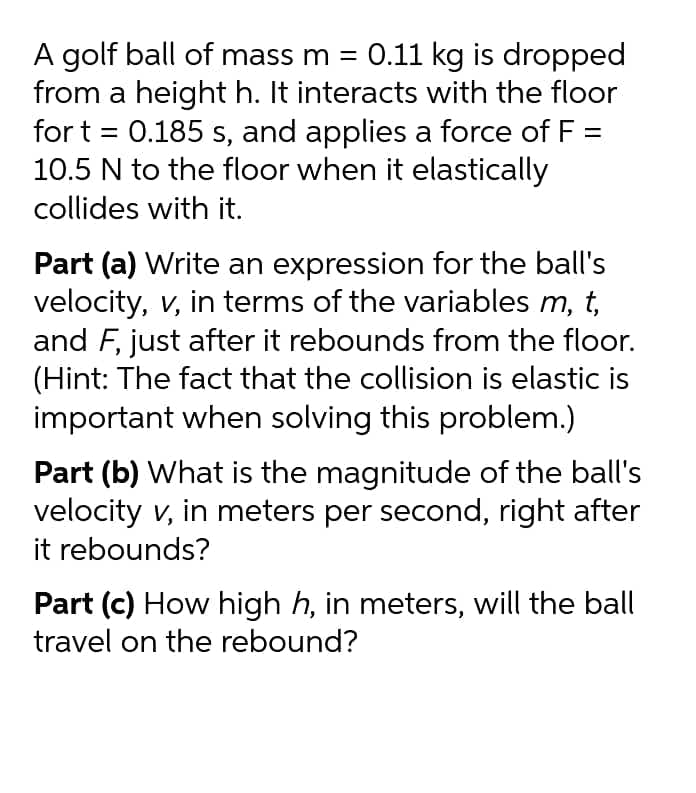A golf ball of mass m = 0.11 kg is dropped from a height h. It interacts with the floor for t = 0.185 s, and applies a force of F = 10.5 N to the floor when it elastically %3D collides with it. Part (a) Write an expression for the ball's velocity, v, in terms of the variables m, t, and F, just after it rebounds from the floor. (Hint: The fact that the collision is elastic is important when solving this problem.) Part (b) What is the magnitude of the ball's velocity v, in meters per second, right after it rebounds? Part (c) How high h, in meters, will the ball travel on the rebound?
A golf ball of mass m = 0.11 kg is dropped from a height h. It interacts with the floor for t = 0.185 s, and applies a force of F = 10.5 N to the floor when it elastically %3D collides with it. Part (a) Write an expression for the ball's velocity, v, in terms of the variables m, t, and F, just after it rebounds from the floor. (Hint: The fact that the collision is elastic is important when solving this problem.) Part (b) What is the magnitude of the ball's velocity v, in meters per second, right after it rebounds? Part (c) How high h, in meters, will the ball travel on the rebound?
Principles of Physics: A Calculus-Based Text
5th Edition
ISBN:9781133104261
Author:Raymond A. Serway, John W. Jewett
Publisher:Raymond A. Serway, John W. Jewett
Chapter8: Momentum And Collisions
Section: Chapter Questions
Problem 6OQ: A 2-kg object moving to the right with a speed of 4 m/s makes a head-on, elastic collision with a...
Related questions
Question

Transcribed Image Text:A golf ball of mass m = 0.11 kg is dropped
from a height h. It interacts with the floor
for t = 0.185 s, and applies a force of F =
10.5 N to the floor when it elastically
collides with it.
Part (a) Write an expression for the ball's
velocity, v, in terms of the variables m, t,
and F, just after it rebounds from the floor.
(Hint: The fact that the collision is elastic is
important when solving this problem.)
Part (b) What is the magnitude of the ball's
velocity v, in meters per second, right after
it rebounds?
Part (c) How high h, in meters, will the ball
travel on the rebound?
Expert Solution
This question has been solved!
Explore an expertly crafted, step-by-step solution for a thorough understanding of key concepts.
This is a popular solution!
Trending now
This is a popular solution!
Step by step
Solved in 2 steps with 2 images

Knowledge Booster
Learn more about
Need a deep-dive on the concept behind this application? Look no further. Learn more about this topic, physics and related others by exploring similar questions and additional content below.Recommended textbooks for you

Principles of Physics: A Calculus-Based Text
Physics
ISBN:
9781133104261
Author:
Raymond A. Serway, John W. Jewett
Publisher:
Cengage Learning

University Physics Volume 1
Physics
ISBN:
9781938168277
Author:
William Moebs, Samuel J. Ling, Jeff Sanny
Publisher:
OpenStax - Rice University

Classical Dynamics of Particles and Systems
Physics
ISBN:
9780534408961
Author:
Stephen T. Thornton, Jerry B. Marion
Publisher:
Cengage Learning

Principles of Physics: A Calculus-Based Text
Physics
ISBN:
9781133104261
Author:
Raymond A. Serway, John W. Jewett
Publisher:
Cengage Learning

University Physics Volume 1
Physics
ISBN:
9781938168277
Author:
William Moebs, Samuel J. Ling, Jeff Sanny
Publisher:
OpenStax - Rice University

Classical Dynamics of Particles and Systems
Physics
ISBN:
9780534408961
Author:
Stephen T. Thornton, Jerry B. Marion
Publisher:
Cengage Learning